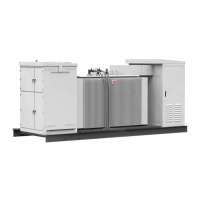3.
The control program generates an indication as defined by parameter 31.22 (refer to
the firmware manual of the inverter).
4. The motor coasts to a stop (if running). The inverter will not restart while the activation
switch or safety relay contacts are open.
5. Deactivate the STO by closing the activation switch, or reseting the safety functionality
that is wired to the STO connection.
6. Reset any faults before restarting.
WARNING!
The Safe torque off function does not disconnect the voltage of the main and
auxiliary circuits from the drive. Therefore maintenance work on electrical parts of
the drive or the motor can only be carried out after isolating the drive from the main
supply.
WARNING!
The Safe torque off functionality is only achieved through the XSTO connector of
the inverter control unit (A41). True Safe torque off functionality is not achieved
through the XSTO connectors of other control units (such as the supply control
unit or the brake control unit).
The Safe torque off function is supported by the ACS880 inverter control program. It is not
supported by supply or brake firmware.
WARNING!
(With permanent magnet or synchronous reluctance [SynRM] motors only) In case
of a multiple IGBT power semiconductor failure, the inverter system can produce
an alignment torque which maximally rotates the motor shaft by 180/p (with
permanent magnet motors) or 180/2p (with synchronous reluctance [SynRM]
motors) degrees regardless of the activation of the Safe torque off function. p
denotes the number of pole pairs.
Notes:
• If a running drive is stopped by using the Safe torque off function, the drive will cut off
the motor supply voltage and the motor will coast to a stop. If this causes danger or is
not otherwise acceptable, stop the drive and machinery using the appropriate stop mode
before activating the Safe torque off function.
• The Safe torque off function overrides all other functions of the inverter unit.
• The Safe torque off function is ineffective against deliberate sabotage or misuse.
• The Safe torque off function has been designed to reduce the recognized hazardous
conditions. In spite of this, it is not always possible to eliminate all potential hazards.
The assembler of the machine must inform the final user about the residual risks.
Maintenance
After the operation of the circuit is validated at start-up, the STO function shall be maintained
by periodic proof testing. In high demand mode of operation, the maximum proof test interval
is 20 years. In low demand mode of operation, the maximum proof test interval is 5 or 2
years; see section Safety data (page 200). It is assumed that all dangerous failures of the
198 The Safe torque off function

